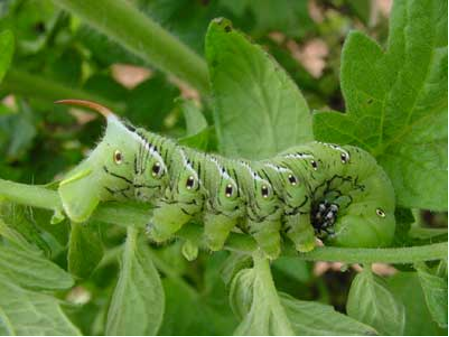Hornworms
go.ncsu.edu/readext?805589
en Español / em Português
El inglés es el idioma de control de esta página. En la medida en que haya algún conflicto entre la traducción al inglés y la traducción, el inglés prevalece.
Al hacer clic en el enlace de traducción se activa un servicio de traducción gratuito para convertir la página al español. Al igual que con cualquier traducción por Internet, la conversión no es sensible al contexto y puede que no traduzca el texto en su significado original. NC State Extension no garantiza la exactitud del texto traducido. Por favor, tenga en cuenta que algunas aplicaciones y/o servicios pueden no funcionar como se espera cuando se traducen.
Português
Inglês é o idioma de controle desta página. Na medida que haja algum conflito entre o texto original em Inglês e a tradução, o Inglês prevalece.
Ao clicar no link de tradução, um serviço gratuito de tradução será ativado para converter a página para o Português. Como em qualquer tradução pela internet, a conversão não é sensivel ao contexto e pode não ocorrer a tradução para o significado orginal. O serviço de Extensão da Carolina do Norte (NC State Extension) não garante a exatidão do texto traduzido. Por favor, observe que algumas funções ou serviços podem não funcionar como esperado após a tradução.
English
English is the controlling language of this page. To the extent there is any conflict between the English text and the translation, English controls.
Clicking on the translation link activates a free translation service to convert the page to Spanish. As with any Internet translation, the conversion is not context-sensitive and may not translate the text to its original meaning. NC State Extension does not guarantee the accuracy of the translated text. Please note that some applications and/or services may not function as expected when translated.
Collapse ▲This article was written by Matthew Clay, 2021 NCSU Summer Intern for North Carolina Cooperative Extension in Lee County.
Hornworms feed typically on solanaceous crops, which include tomatoes and tobacco. There are two species of hornworm that can be found in North Carolina: the tobacco hornworm (Manducta Sexta) and the tomato hornworm (Manduca quinquemaculate). Damage caused by each one is similar. There are seven diagonal stripes on the sides of the tobacco hornworm, and its horn is usually red, while the tomato hornworm has V-shaped white markings on its sides, and the horn is frequently black.
In June, overwintering adults will emerge from pupae as moths. A moth can lay up to 2,000 eggs and will lay around five eggs per plant visit, which typically happens at dust. Eggs are light green and turn white right before hatching, which takes about four days. One can check for eggs by checking the underside of the leaves. Once the larvae emerge plant destruction will occur. Defoliation of leaves is the most common damage, but fruit damage of tomato plants can also occur.
With our climate in North Carolina, three generations of hornworms can occur during the season with pest pressure being the highest in July. Frequently check your plants to determine if hornworms are present. Look for black droppings on leaves and observe for signs of leaf and fruit damage as an indication if a hornworm infestation has occurred.
Hornworms are naturally controlled by the braconid wasp and can be easily recognized from the white pupae attached to the Hornworm. One should not remove these hornworms if found on a plant to promote natural predation. During

Hornworm
most seasons, the parasitic wasps can keep the hornworm at low levels. However, homeowners can hand remove hornworms when found on a plant and place them in a bucket of soapy water. If insecticides are your preferred option, they should contain the active ingredient neem oil, spinosad, and azadirachtin. Make sure to follow the label recommendations to apply the right amount, rate, and at the right time. Roto-tilling the soil after fruit harvest is very effective, and tillage has been shown to destroy up to 90 percent of the caterpillars pupating in the soil. For more information about hornworms and other pests visit Insect and Related Pests of Vegetables.
Matthew Clay is the 2021 Summer Intern for North Carolina Cooperative Extension in Lee County.




